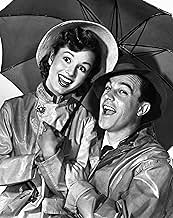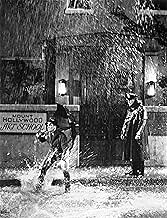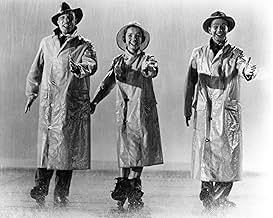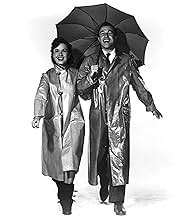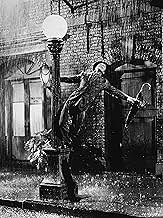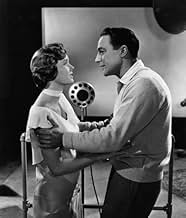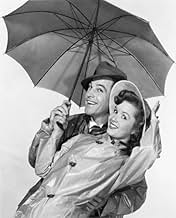Uma produtora de cinema mudo e seu elenco enfrentam uma transição difícil para o cinema falado.Uma produtora de cinema mudo e seu elenco enfrentam uma transição difícil para o cinema falado.Uma produtora de cinema mudo e seu elenco enfrentam uma transição difícil para o cinema falado.
- Direção
- Roteiristas
- Artistas
- Indicado a 2 Oscars
- 11 vitórias e 11 indicações no total
Dawn Addams
- Teresa - a Lady-in-Waiting
- (não creditado)
John Albright
- Call Boy
- (não creditado)
Shirlee Allard
- Chorus Girl
- (não creditado)
Bebe Allen
- Chorus Girl
- (não creditado)
Sue Allen
- Chorus Girl
- (não creditado)
John Angelo
- Dancer
- (não creditado)
Marie Ardell
- Chorus Girl
- (não creditado)
Bette Arlen
- 'Miss January' in 'Beautiful Girl' segment
- (não creditado)
David Bair
- Chorus Boy
- (não creditado)
Jane Bateman
- Chorus Girl
- (não creditado)
- Direção
- Roteiristas
- Elenco e equipe completos
- Produção, bilheteria e muito mais no IMDbPro
Resumo
Reviewers say 'Singin' in the Rain' is a celebrated classic, praised for its charm, wit, and infectious energy. Gene Kelly's performance, especially in the title number, is lauded for its seamless blend of dancing, singing, and charisma. The supporting cast, including Debbie Reynolds and Donald O'Connor, is commended for their stellar performances and chemistry. The film's vibrant choreography, clever script, and memorable musical numbers are frequently celebrated. Despite minor criticisms about predictability and humor, it remains a beloved musical.
Avaliações em destaque
Singin' in the Rain is one of the best movies ever made. The film is beautiful, tuneful, and loads of fun. While it pokes fun at Hollywood it also does so with great love. Little bits and pieces of Hollywood lore find their way into this great film and it's a pleasure to get the joke or recognize the real star they're referring to.
The star trio is just perfect: Gene Kelly give a funny performance as the hammy silent actor; Donald O'Connor makes the most of his "second banana" role; Debbie Reynolds is perfect as the ingénue trying to break into films.
The three stars perform many memorable numbers, including Kelly's "Singin' in the Rain" classic; all three in the "Good Mornin'" number; O'Connor's "Make 'Em Laugh"; and Kelly and Reynolds in "You Were Meant for Me." The masterpiece however may be the "Gotta Dance" production number with Kelly and Cyd Charissejust perfect. Also great fun are O'Connor and Kelly in "Fit as a Fiddle" and "Moses Supposes."
There are of course other production numbers, including the montage that shows Hollywood's race to transition to talkies, a scene that ends in the "Beautiful Girl" number featuring Jimmy Thompson.
Jean Hagen (as Lina Lamont) won an Oscar nomination and steals the film in a classic comedy performance. Also good are Millard Mitchell, Douglas Fowley, Rita Moreno, King Donovan, Kathleen Freeman, Mae Clarke, Julius Tannen, and Madge Blake.
The great trick to this film is that while Reynolds is supposedly "lip syncing" for Hagen, it's really Hagen's voice that Reynolds is miming to as in the "I Would, Would You" number. The final miming act is Hagen mouthing "Singin' in the Rain" is really Reynolds. It gets so confusing you can't tell who is lip syncing whose voice.
Lots of Hollywood lore retold in this film. Hagen's Lamont character is a veiled reference to Norma Talmadge, who supposedly failed in talkies because of her New York accent. It's also a reference to Louise Brooks, whose talkie debut in The Canary Murder Case was all dubbed. When Kelly screams "I LOVE YOU" it's a reference to John Gilbert in is talkie debut flop. His Glorious Night. Kathleen Freeman's diction coach character is a reference to Constance Collier, who returned to Hollywood as a coach. And on it goes.
A great film!
The star trio is just perfect: Gene Kelly give a funny performance as the hammy silent actor; Donald O'Connor makes the most of his "second banana" role; Debbie Reynolds is perfect as the ingénue trying to break into films.
The three stars perform many memorable numbers, including Kelly's "Singin' in the Rain" classic; all three in the "Good Mornin'" number; O'Connor's "Make 'Em Laugh"; and Kelly and Reynolds in "You Were Meant for Me." The masterpiece however may be the "Gotta Dance" production number with Kelly and Cyd Charissejust perfect. Also great fun are O'Connor and Kelly in "Fit as a Fiddle" and "Moses Supposes."
There are of course other production numbers, including the montage that shows Hollywood's race to transition to talkies, a scene that ends in the "Beautiful Girl" number featuring Jimmy Thompson.
Jean Hagen (as Lina Lamont) won an Oscar nomination and steals the film in a classic comedy performance. Also good are Millard Mitchell, Douglas Fowley, Rita Moreno, King Donovan, Kathleen Freeman, Mae Clarke, Julius Tannen, and Madge Blake.
The great trick to this film is that while Reynolds is supposedly "lip syncing" for Hagen, it's really Hagen's voice that Reynolds is miming to as in the "I Would, Would You" number. The final miming act is Hagen mouthing "Singin' in the Rain" is really Reynolds. It gets so confusing you can't tell who is lip syncing whose voice.
Lots of Hollywood lore retold in this film. Hagen's Lamont character is a veiled reference to Norma Talmadge, who supposedly failed in talkies because of her New York accent. It's also a reference to Louise Brooks, whose talkie debut in The Canary Murder Case was all dubbed. When Kelly screams "I LOVE YOU" it's a reference to John Gilbert in is talkie debut flop. His Glorious Night. Kathleen Freeman's diction coach character is a reference to Constance Collier, who returned to Hollywood as a coach. And on it goes.
A great film!
One thing I noticed in reading the comments of this movie is that nobody recognized the screenplay by Betty Comden and Adolph Green. Without their screenplay the movie does not get made. It is a great script that was made better by Gene Kelly and Stanley Donens' fluid direction. Everything in this movie glides effortlessly. Throw in dancing by Donald O'connor, Debbie Reynolds, Cyd Charisse and of course Gene Kelly, Great songs and the willingness of producer Arthur Freed to let the creative people to do their thing and you have a classic.
It's the magic that seldom appears, whose longevity is perpetual, the pleasure of enjoying the perfections that people, music and great storytelling can sometimes offer, with the backdrop a little piece of cinema history itself. All without foul language, extravagant pyrotechnics, mass brawls and bullets ricocheting all over the place, just immensely talented people doing what they do best - keeping you entertained and allowing you to escape for a while and live with the dreams of others. Whether musicals are you thing or not, there can be no doubt that you witness greatness as you welcome the rain and it makes your heart sing.
Everybody knows Gene Kelly singing and dancing in the films title number, but this is just one of the many magical musical numbers in this epic piece of blissful entertainment. Set during the turbulent period when Hollywood was converting from silent films to sound, Singin' in the Rain' is a perfect example of everything that is good and right about movie-making. Gene Kelly in his greatest role is an all singing, all dancing sensation and his acting is pretty damn good too. Donald O'Connor excels as his exuberant sidekick and almost steals the show with the unsurpassed Make em Laugh'. Debbie Reynolds is feisty and sexy as Kelly's love interest, while Jean Hagen gives one of the screen's greatest supporting performances as the horrid Lena Lamont, a silent screen goddess whose voice will just not cut it in talkies.
The musical numbers flow fast and furious as Gene and Donald perform amazing feats of choreography with Fit as a Fiddle' and Moses Supposes' while Good Mornin' will have you dancing in the aisles. If Singin' in the Rain' had no musical numbers it would still be a contender for the funniest film ever made. The problems with experiments with sound films are painfully funny, and Kelly's silent sparring with the demonic Hagen is hilarious. The accolade of sheer perfection can be conferred on few films, and such a title is perhaps even an understatement in this case. And never before did rain look like so much fun.
The musical numbers flow fast and furious as Gene and Donald perform amazing feats of choreography with Fit as a Fiddle' and Moses Supposes' while Good Mornin' will have you dancing in the aisles. If Singin' in the Rain' had no musical numbers it would still be a contender for the funniest film ever made. The problems with experiments with sound films are painfully funny, and Kelly's silent sparring with the demonic Hagen is hilarious. The accolade of sheer perfection can be conferred on few films, and such a title is perhaps even an understatement in this case. And never before did rain look like so much fun.
Don Lockwood (Gene Kelly) and Lina Lamont (Jean Hagen) are a famed Hollywood duo, making films at the tail end of the silent era. The studio has been issuing PR suggesting that they're a romantic item. In reality, they can barely stand one another. One night, while on the town with his best friend Cosmo Brown (Donald O' Connor), Lockwood has to run to escape fans who want a piece of him badly enough that they'll literally rip his clothes to shreds. He hops over a number of moving vehicles and ends up in the passenger seat of Kathy Selden's (Debbie Reynolds) car. Lockwood seems immediately taken with her, but she gives him the cold shoulder. She says she's an actress with a love of theater, and she looks down on film acting. Later, Lockwood discovers that she was inflating the truth a bit, as he sees Selden performing as a cute song & dance girl at an industry party he's attending. She runs out of the party and Lockwood chases after her, but he's too late. While he tries to track her down, he, Lamont and their studio have to deal with the changing nature of film in 1927--made much more difficult by the fact that Lamont may look glamorous, but she talks more like Fran Drescher in "The Nanny" (1993).
Aside from the more serious aspects of the plot, Singing in the Rain is a great success as a romance and a musical. It also has an astoundingly rich Technicolor look, and it is charmingly humorous. Kelly and Reynolds click on screen, even if offscreen Kelly, who also co-directed and co-choreographed, was famously difficult to work with--he drove Reynolds so hard (she was a much more inexperienced dancer) that her feet literally started bleeding at one point. The songs are great, they're worked into the story well--which is perhaps surprising given that most of them weren't written specifically for this film--and the choreography is impeccable, frequently jaw dropping and always aesthetically wondrous and sublime. If for nothing else, the film is worth a look for its often-athletic dance numbers, which can resemble Jackie Chan's showy martial arts stunts as much as dancing. It's also imperative viewing for cultural literacy in the realm of film.
But the more serious aspects of the plot are fascinating as well. In a significant way, Singing in the Rain is about film technology. Film technology is the hinge of the plot, after all. The climax and dénouement are decided by the advent of synchronized sound in the film industry. We see studio head R.F. Simpson (Millard Mitchell) demonstrating sound films at the party where Lockwood sees Selden for the second time, providing two big turning points at once. There are sequences of actors heading off to diction coaches, as happened in reality once sound entered the scene, and also in reality as in the film some actor's careers were jeopardized by having to suddenly master a new skill.
But Singing in the Rain is about technology on another level, too. Kelly and co-director Stanley Donen go to great lengths to ensure that the film is an exemplar of state-of-the-art film technology in 1952. For example, the beautiful Technicolor cinematography is emphasized by the fabulously colorful costumes and production design--they're showing off cutting edge color. The sound is as good as it could be in 1952, and the fact that this is a musical helps show that off. The sets and effects are complex and an attempt is made to show them off as well.
Donen and Kelly often play up the artificiality of the sets and effects to emphasize artistry and technology. This is clearly shown in the "Make 'Em Laugh" sequence (and surrounding events) and the extended "Broadway Rhythm Ballet" sequence with Cyd Charisse. Showing off this artistry and technology also occurs very subtly, as with the rain in the "Singing in the Rain" sequence. Even today, rain machines are frequently employed in a way that it appears to be raining on film, but in reality, it's just enough coverage to produce the illusion. In the "Singing in the Rain" sequence, they make sure that you can see the whole area is getting flooded, and they use Gene Kelly's umbrella, as torrents of water bounce off of it, to emphasize that no matter where he goes, "rain" is pouring down on him.
While there are many musicals I like as much as Singing in The Rain, this is one of the better-loved examples of that genre, and for good reason. Any musical lover has surely seen this already, and if not, they should run out now and pick it up on DVD. If you're relatively unfamiliar with classic Hollywood musicals, this is one of the best places to start.
Aside from the more serious aspects of the plot, Singing in the Rain is a great success as a romance and a musical. It also has an astoundingly rich Technicolor look, and it is charmingly humorous. Kelly and Reynolds click on screen, even if offscreen Kelly, who also co-directed and co-choreographed, was famously difficult to work with--he drove Reynolds so hard (she was a much more inexperienced dancer) that her feet literally started bleeding at one point. The songs are great, they're worked into the story well--which is perhaps surprising given that most of them weren't written specifically for this film--and the choreography is impeccable, frequently jaw dropping and always aesthetically wondrous and sublime. If for nothing else, the film is worth a look for its often-athletic dance numbers, which can resemble Jackie Chan's showy martial arts stunts as much as dancing. It's also imperative viewing for cultural literacy in the realm of film.
But the more serious aspects of the plot are fascinating as well. In a significant way, Singing in the Rain is about film technology. Film technology is the hinge of the plot, after all. The climax and dénouement are decided by the advent of synchronized sound in the film industry. We see studio head R.F. Simpson (Millard Mitchell) demonstrating sound films at the party where Lockwood sees Selden for the second time, providing two big turning points at once. There are sequences of actors heading off to diction coaches, as happened in reality once sound entered the scene, and also in reality as in the film some actor's careers were jeopardized by having to suddenly master a new skill.
But Singing in the Rain is about technology on another level, too. Kelly and co-director Stanley Donen go to great lengths to ensure that the film is an exemplar of state-of-the-art film technology in 1952. For example, the beautiful Technicolor cinematography is emphasized by the fabulously colorful costumes and production design--they're showing off cutting edge color. The sound is as good as it could be in 1952, and the fact that this is a musical helps show that off. The sets and effects are complex and an attempt is made to show them off as well.
Donen and Kelly often play up the artificiality of the sets and effects to emphasize artistry and technology. This is clearly shown in the "Make 'Em Laugh" sequence (and surrounding events) and the extended "Broadway Rhythm Ballet" sequence with Cyd Charisse. Showing off this artistry and technology also occurs very subtly, as with the rain in the "Singing in the Rain" sequence. Even today, rain machines are frequently employed in a way that it appears to be raining on film, but in reality, it's just enough coverage to produce the illusion. In the "Singing in the Rain" sequence, they make sure that you can see the whole area is getting flooded, and they use Gene Kelly's umbrella, as torrents of water bounce off of it, to emphasize that no matter where he goes, "rain" is pouring down on him.
While there are many musicals I like as much as Singing in The Rain, this is one of the better-loved examples of that genre, and for good reason. Any musical lover has surely seen this already, and if not, they should run out now and pick it up on DVD. If you're relatively unfamiliar with classic Hollywood musicals, this is one of the best places to start.
Você sabia?
- CuriosidadesFor the "Make 'em Laugh" number, Donald O'Connor revived a trick he had done as a young dancer: running up a wall and completing a somersault. The number was so physically taxing that O'Connor ended up in a hospital bed for a week after its completion. He suffered from exhaustion and carpet burns. After an accident ruined all of the initial footage, O'Connor agreed to do the difficult number all over again.
- Erros de gravaçãoDuring the Cyd Charisse nightclub dance number, when she's wrapped around Gene Kelly, her body completely changes position between frames due to a clumsy edit. According to commentary on the special edition DVD, this cut of only a few frames' duration dates back to the original release of the film and no one knows why it exists.
- Citações
Cosmo Brown: Lina. She can't act, she can't sing, she can't dance. A triple threat.
- ConexõesEdited from Os Três Mosqueteiros (1948)
- Trilhas sonorasFit as a Fiddle
(1932)
Music by Al Hoffman (uncredited) and Al Goodhart (uncredited)
Lyrics by Arthur Freed
Originally from the 1932 stage revue "George White's Music Hall Varieties"
Sung by Gene Kelly (uncredited) and Donald O'Connor (uncredited)
Principais escolhas
Faça login para avaliar e ver a lista de recomendações personalizadas
Detalhes
- Data de lançamento
- País de origem
- Idioma
- Também conhecido como
- Cantando bajo la lluvia
- Locações de filme
- Metro-Goldwyn-Mayer Studios - 10202 W. Washington Blvd., Culver City, Califórnia, EUA(New York City Streets)
- Empresa de produção
- Consulte mais créditos da empresa na IMDbPro
Bilheteria
- Orçamento
- US$ 2.540.800 (estimativa)
- Faturamento bruto nos EUA e Canadá
- US$ 1.884.537
- Fim de semana de estreia nos EUA e Canadá
- US$ 13.643
- 10 de nov. de 2002
- Faturamento bruto mundial
- US$ 2.096.442
- Tempo de duração
- 1 h 43 min(103 min)
- Cor
- Mixagem de som
- Proporção
- 1.37 : 1
Contribua para esta página
Sugerir uma alteração ou adicionar conteúdo ausente








